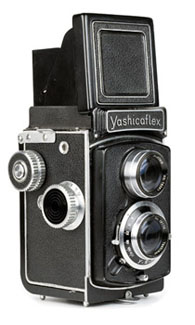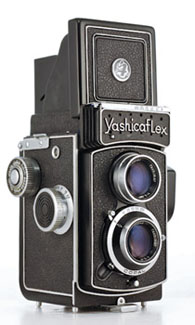Yashicaflex A Series
Models A-I, A-II, AS-I, AS-II, A-III, A2 & A (new model)
(see also “66 Models”)
Contents
The Early “A” Series
Cable Release and Press Button Shutters
Comparison & Development of Early “A” Series
Documentation Identifying Models and Specs
Yashicaflex A2, Yashicaflex unknown model & Yashicaflex A (new model)
Export or Domestic?
Note that the 1957 Yashicaflex AS with Citizen shutter and control wheels (forerunner of the Yashicaflex B, Yashica 635 and Yashica D) seems to reuse the “AS” name more for marketing purposes than any other reason that I can understand (including utilising both the earlier AS presentation box and A-II style ever-ready case) - I don't consider it to be part of the A series in regard to features or position in the range.
The Early “A” Series
(Images courtesy of Tom Heckhaus)
Early versions of the first A series cameras: A-I, A-II and AS-II examples (the A-I from slightly later than the beginning, the A-II with Y.S.K. shutter and other early features still). The AS-I belongs to this group but I am not aware of any examples found. The A-I and A-II are claimed to be released in October 1954 and the two AS models with exposure meters in November 1954. The dates, including the month difference, fit well with historical details including shutter differences between the Yashicaflex A and Yashicaflex AS user manuals explained in the Yashicaflex AS-II entry in 66 Models.
Yashima seemed to use “Yashicaflex A” and “Yashicaflex AS” in the generic sense when referring to models A-I and A-II and models AS-I and AS-II respectively. The logic of this convention is covered further down the page. Where possible, I try to use the actual model names to avoid confusion but sometimes the generic name is useful.
There is no doubt that the the “A” series were conceived as low cost, entry level cameras. However, the basic bodies and build quality remained the same as the more expensive models and even some advanced features were made available in various mixes. The savings were in the specs.
The Pigeonflex, Yashima Flex and Yashica Flex B were sequential releases with minor upgrades. Even by the standards of the time, their feature sets were basic. After Yashima released the more advanced Yashica Flex S with selenium cell exposure meter (a Japanese first) with Bay 1 mounts and auto stop film winding and film counter (both new to Yashima but not Japanese TLRs), Yashima developed a budget line which seemed to be based on the earlier models. The most basic Yashicaflex A-I was little more than a Yashica Flex B with shutter and lens downgrades. Later, with a minor shutter upgrade in speed range, it eventually became the long running Yashica A. In budget guise, these cameras lost the self-timer, the speeds were reduced from 1-1/300 to 1/10-1/200 and initially, the button release was replaced by cable release. The new Yashimar lenses were also found on budget models only. The evidence suggests that the Yashica Flex B perhaps continued on for a while longer as a more upmarket camera and later in 1955, the Yashicaflex S was joined by its unmetered companion, the Yashicaflex C.
The variations of the Yashicaflex A series are complex, hence the need for this dedicated section. Looked as a whole, there is the early type/ late type body, red window/ auto-stop with film counter, cable release shutter/ press button release shutter and film speed reminder/ plain film wind knob. Apart from the A-III and the later A2 and A (new model), all share the Copal 1/10-1/200 shutter, except for the very first Yashicaflex A-I and A-II examples which were fitted with a Y.S.K. shutter of similar specification (seven A-Is and twenty five A-IIs found plus the example in the Yashicaflex A user manual). The first cameras were reputed by some sources to have Tri-Lausar lenses. Because of the intent of the A series, I am certain that those sources have made a mistake. All I have found are fitted with Yashimars including those with Y.S.K. shutters and the very early examples in the Yashicaflex A and AS user manuals.
What feature set divides the early A series? The auto-stop film winding and counter is what defines the A-II from the A-I. The AS-I is an A-I with exposure meter. The AS-II is an A-II with exposure meter (or alternatively viewed as an AS-I with film counter). Cable release was fitted to early cameras, press button on later examples including move of the flash sync to the front panel. Given that the same trim variations, including the shutter cable release/ press button, appear across all three models, it would be safe to assume that they were pretty much concurrent models. This is confirmed by Yashima documentation.
Note that in Japan, the A-II may have been simply known as the “Yashicaflex Model A”. More details are here.
Cable Release and Press Button Shutters
The leaf shutters supplied by shutter companies were complete assemblies and in different sizes used in many applications including folding and view cameras. In their most basic form, they were operated by a cable release on the side and also an integral lever, usually in the middle of the lower edge. I will refer to these shutters as “cable release” as opposed to “press button”. The examples below are all Yashicaflex A-I versions, early to late, but apply equally to A-II and AS-II models:
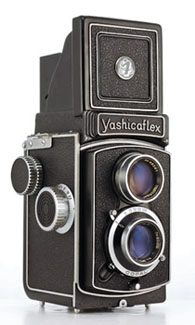
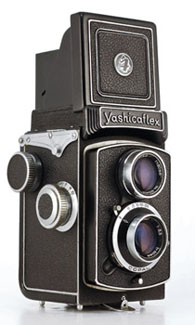
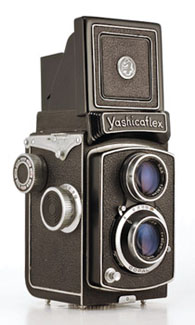
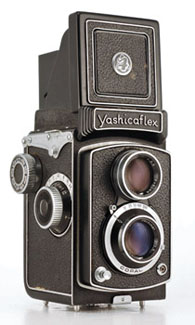
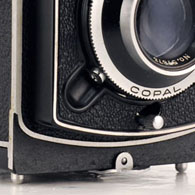
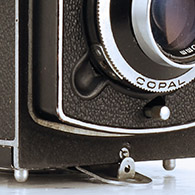
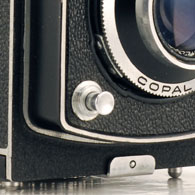
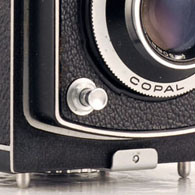
(Images courtesy of Tom Heckhaus, note camera 2 has an improvised focusing knob cap)
Camera 1 is early bodied Yashicaflex A-I with cable release shutter and a screw-in ferrule for the cable release socket which has sometimes been lost, camera 2 is a later bodied example with the ferrule replaced by a more secure screw fastened plate with tapped hole for the cable, camera 3 is a later bodied version with press button shutter and plain cover plate on the shutter housing and finally, camera 4, the transformation is complete - no evidence of a cable release ever having been fitted. The steps seem to suggest that the release type is perhaps more a shutter development issue than a camera maker's choice but either way, the issue was probably cost, i.e. selecting the most basic option. It also had benefits for those that often preferred to use a cable release but I doubt that was a design priority.
Up to the end of 1950, the Rolleicord II series had a similar cable release arrangement with their Compur shutters. However, the centre lever combined both shutter tensioning and release.
Comparison & Development of Early “A” Series
Below is a table that compares the feature sets of the four original “A” models against the “S”. The A-I and A-II are claimed to be released in October 1954 and the AS-II in November 1954. The “S”, I believe, was in 1954 as claimed but much earlier than the others. The Yashica Flex B was still in production but near its end and the Yashicaflex C didn't arrive until probably later in 1955, the A-III at a similar time and the A2 and A (new model) models later still. Trim changes that applied across the whole of the range such as spool knob design and move of flash sync to the front (low set on “A” models, high set on “S”, a convention that carried through to the later Yashica A and premium models) are not included. (Note. Whilst this table relies on details found on actual cameras, I have not yet found any confirmed red windowed AS-I examples other than reference to its existence in both the original Yashicaflex A and AS user manuals from probably late 1954 and a later combined manual - see further down.)
(Click on table for full screen view)
Note: The Yashicaflex AS-II in the instruction manual has the film wind knob from the A-II rather than from the Yashica Flex S as on later cameras. However, this is possibly a pre-production example.
Documentation Identifying Models and Specs
(Note that the manuals referred to below are available in full as PDFs accessible from the 66 Models and Ownership pages and the brochure is on the Brochures page.)
The “Yashicaflex Directions for use Model A and C” covers the more recent A variations (late 1955, early 1956), i.e., long strap holder, press button shutter release models, as well as the Yashicaflex C and Yashica Flex S, now called the Yashicaflex S in line with its new peers. Tom Heckhaus' example has “purchased Okinawa Feb 1957” penned on the cover.

Inside is detail referring to the various models in production at the time:

The page referred to as “Instructions for Models S & AS see separate page attached” is often missing - two of four examples of the Directions I am aware of have the page:
(Click on image for larger view)
The “A” models listed are the A-I, A-II and A-III. The A-I is what some have commonly referred to as the Yashicaflex A, perhaps encouraged by the box which simply states “Yashicaflex Model A” but in Japan, it is the A-II which is more likely to be called the Yashicaflex Model A. The A-II with film counter and auto-stop winding is described in the brochure below which also notes that the A-I uses “the Film Counting Window on back of the camera”.
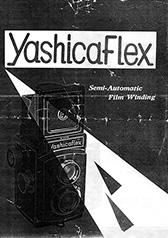 (Full PDF linked from Brochures page, courtesy of Tom Heckhaus)
(Full PDF linked from Brochures page, courtesy of Tom Heckhaus)

Unlike the earlier “A” models, the A-III has a Seikosha MX Shutter with 1/500 speed and M/X flash synchronisation (a Seikosha Rapid shutter with “MX” synchronisation as per the Yashima description above), Yashikor lenses, auto stop winding and plain filter mounts. Apart from basic shutter specs, all other details are based on this one example:

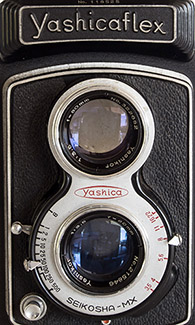
The plain filter mounts are still 32 mm, unlike later models with faceplate over the shutter and plain filter mounts which use a 36 mm mount. By trim, it was probably released at a similar time to the Yashicaflex C in 1955 or just later (the first model Cs have a locking lever the same as on the late A-I and A-II and Yashica Rookie and A - this A-III example has a bent strap locking lever). Although fitted with a superior shutter, it lacked the Bay 1 mounts and self-timer of the Yashicaflex C and by its “A” designation, would almost certainly have sat below that model. Whereas the Yashicaflex C appears in 1956 and 1957 Japanese brochures, there is no hint of the A-III.
The Directions confirm that the Yashicaflex AS is a metered “A” series model (note that this is a completely different model to the 1957 Yashicaflex AS with control wheels and Citizen shutter). It also identifies the “AS-II” model and describes both as “identical to model A but with built in exposure meter”. But what does that exactly mean? Here is a page at the back of an earlier Yashicaflex A manual (probably dating from the camera's release, other pages and the full manual appear throughout this site):
(Click on image for larger view)
Therefore, the “AS” is clearly expected to have a red window and the “AS-II” is clearly an A-II with meter. Here is another page of the above referenced advertising brochure:

(Brochure courtesy of Tom Heckhaus)
Inside, it has details of the A-I and A-II but nowhere is there mention of the red windowed AS as in the Directions above. Adding to the confusion is this “Yashicaflex AS” manual (probably dates from close to the Yashicaflex A manual) which seems to be mainly for the Yashicaflex AS-II but also covers the “AS-I” by the note: “If you purchased the AS-I Model instructions are the same except that you wind your film using the film counting window on the side of the camera.” (I think that this is referring to the red window on the back, the parts diagram for the AS-II refers to the film counter on the side as “Film Counting Dial Window” - this was still the period when Japanese use of English grammar in manuals was poor.)

(Manual courtesy of Tom Heckhaus)
(Click pages 1 & 2 and 3 & 4 for larger views)
Apart from some obscure web references, I have found no other traces of the red windowed AS or AS-I other than in the above multi-model user manuals, or “Directions” and in Karl F. Kahlau's book in the list “partly supplied by Yashica/Kyocera”. However, I think that he has got the names confused, missing the actual AS-I, calling the AS-II an AS-I and calling the unrelated 1957 AS an AS-II.
As I mention on the “Model Names” page and also above, Yashima seemed to use the names “Yashicaflex A” and “Yashicaflex AS” generically for the two groups of early models. Presentation boxes also do this to a point. I have found boxes marked “Yashicaflex Model A”, used for both the export model A-I and domestic Japanese market A-II, “AII” used for the export version of the A-II only and “AS” used for the AS-II, possibly also the AS-I and certainly for the unrelated later 1957 model with control wheels, Citizen shutter and no meter. Although there were some lapses (e.g. using “AS” when “AS-I” would have been more consistent in some examples above, literature generally identified specific models, i.e. “A-I”, “A-II”, “A-III”, “AS-I” and “AS-II”, except on the covers of multi-model manuals which are generic. It is very difficult to have hard and fast rules with the Yashicaflex period but when viewed across a range of period documentation, I don't think that there is any doubt about the correct model names and features.
Yashicaflex A2, Yashicaflex unknown model & Yashicaflex A (new model)
(see also “66 Models”)
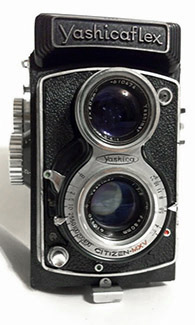
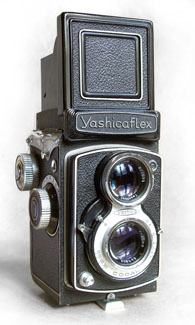
(Left image courtesy of Sandu Baciu, right image courtesy of Leigh Harris)
There were also two later A models, the Yashicaflex A2, released in October 1956, and the less well known Yashicaflex A (new model) released in August 1957. The first had a red window but a high spec Citizen MXV shutter (replaced by Copal MXV near the end of production). The Yashicaflex A (new model) added film counter with auto-stop winding and Yashikor lenses but it had a lower spec Copal shutter from the Yashica A. A year later, it was also released as the Yashica B. All three had 36 mm plain filter mounts with a cover plate somewhat like Bay 1 mount models. Incidentally, although the nameplate says “Yashicaflex”, marketing material calls this “Yashica A” in Japan. Sugiyama and/or collectors have added the “(new model)” to differentiate it from the earlier Yashicaflex A-I/A-II or perhaps because the A-II may have been known as the “Yashicaflex A” in Japan. The Yashicaflex A (new model) may have replaced the Yashicaflex A-II and/or the Yashica Rookie as the base model(s) in the Japanese domestic market until the many coloured Yashica A III model (Yashica A elsewhere) made its late arrival in 1959.
In between the A2 and A (new model), from a similar time as the A2, is another unusual niche model with high spec Copal MXV shutter, Bay 1 filter mounts but budget Yashimar lenses and film advance by red window. It undoubtedly fits the A series model structure but I have not been able to link it to a model name even though there are six examples in my database. It is essentially a late model A2, Copal MXV shutter version, but with Bay 1 lens mounts replacing the plain 36 mm type. I have postulated that it could simply be an upgraded A2 but that is just a guess:
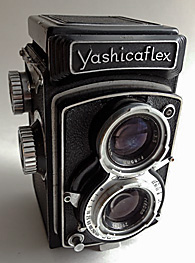 (Image courtesy of Sandu Baciu)
(Image courtesy of Sandu Baciu)
Export or Domestic?
Which markets these models were intended for are covered in their individual model entries on the 66 Models pages. However, in brief, only the Yashicaflex A-I and Yashicaflex AS-II seem to have been intended as mainly export models. I have only found very early examples of the A-I in Japan and no AS-IIs at all. The A-II certainly was exported but it is also one of the most common models on Japanese auction sites.
The other Yashicaflex A series cameras seem to have been intended for domestic consumption only. The Yashica A, C and LM were released towards the end of 1956 starting the use of the “Yashica” nameplate for export models.
